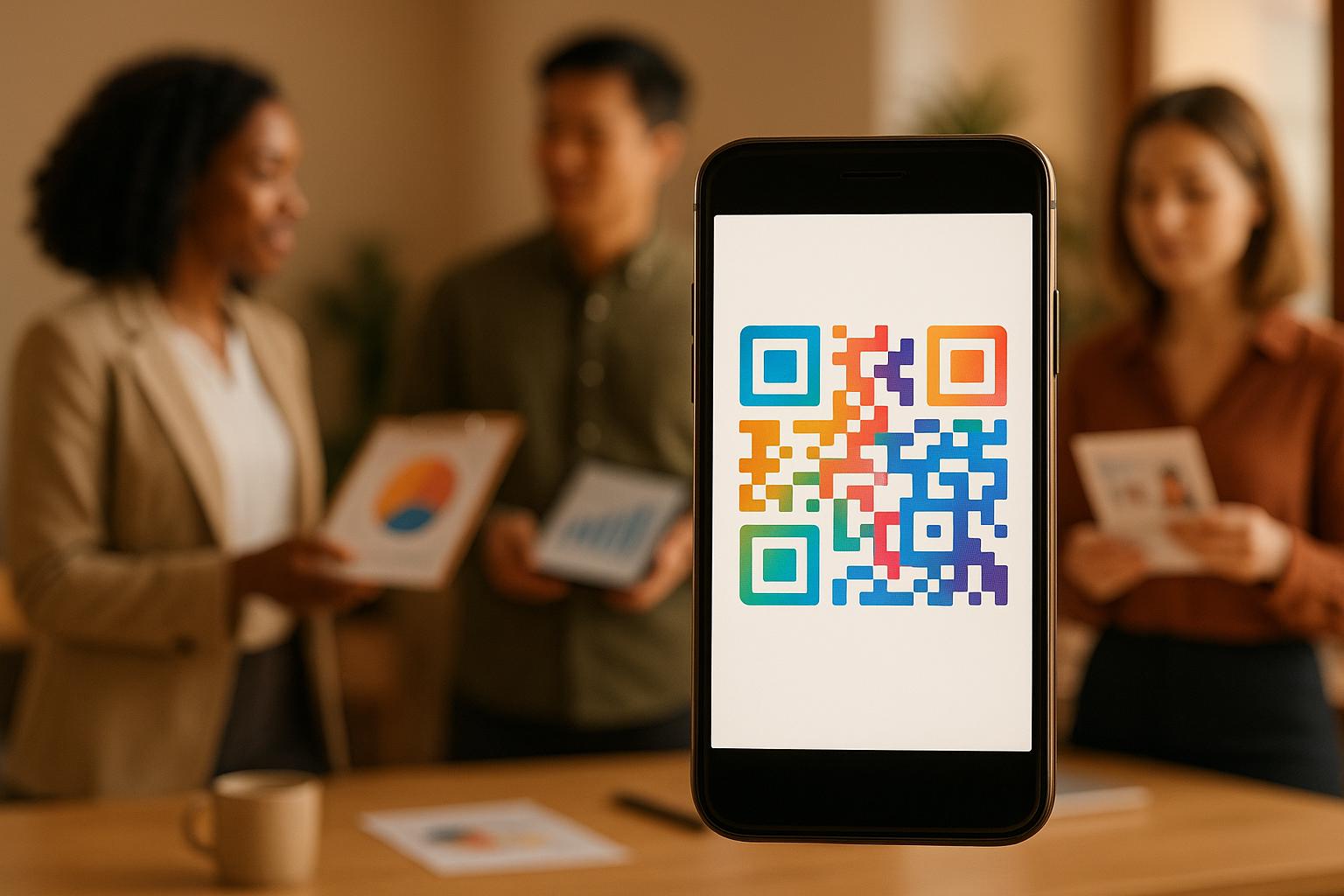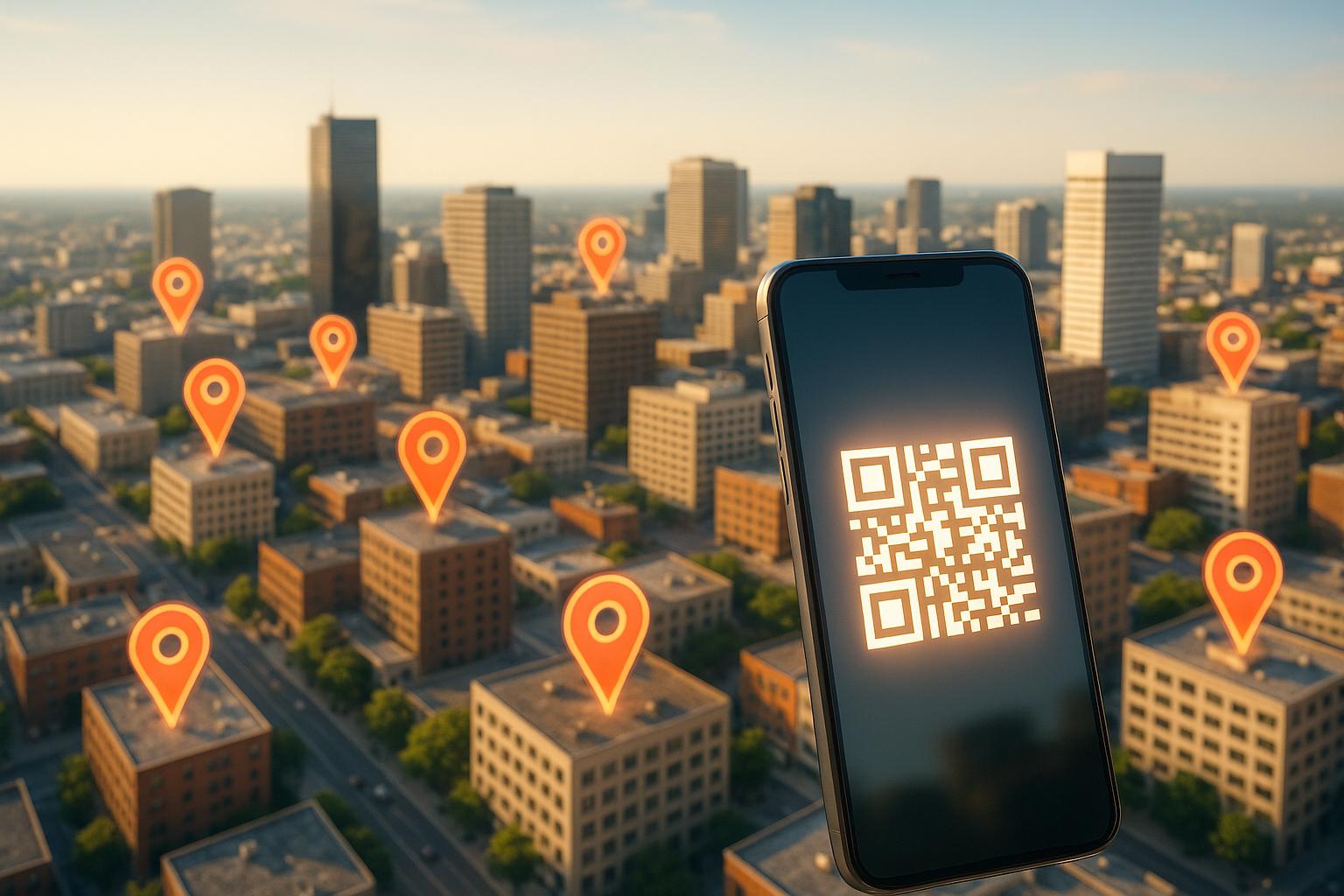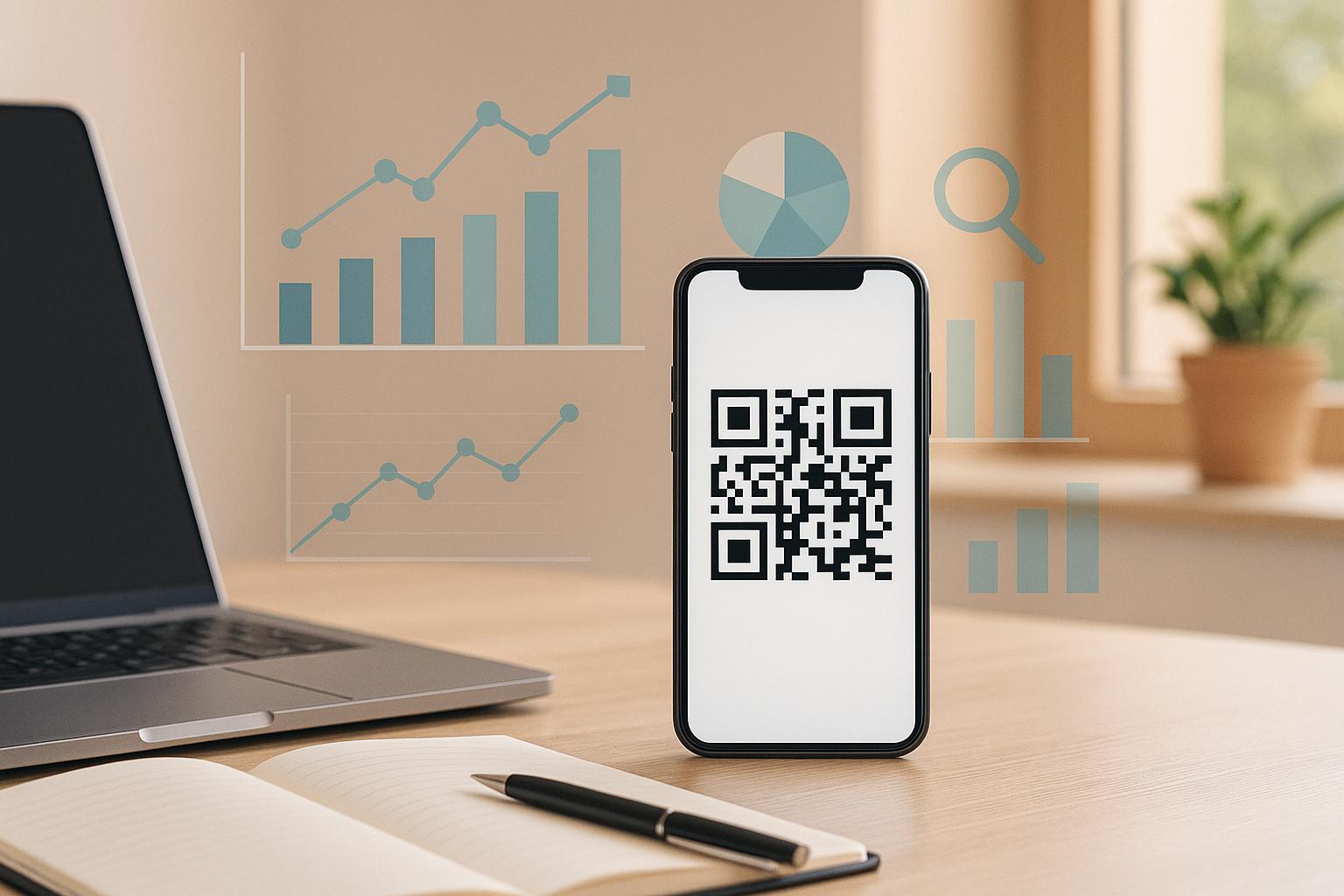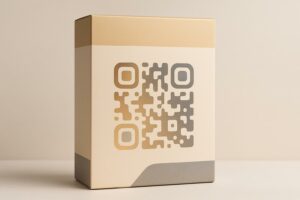Dynamic QR codes aren’t just for sharing links – they’re a powerful tool for gathering demographic data and improving marketing strategies. Here’s what you need to know:
- What They Are: Unlike static QR codes, dynamic QR codes allow businesses to track scans, update destinations post-printing, and collect real-time data.
- Why They Matter: They deliver insights like user location, device type, and behavior patterns, helping businesses fine-tune campaigns and target audiences effectively.
- How They’re Used: From tracking event attendance to personalizing marketing campaigns, dynamic QR codes turn every scan into actionable insights.
- Privacy Compliance: Businesses must follow regulations like GDPR and CCPA to ensure data is handled responsibly.
Dynamic QR codes offer a smarter way to connect with customers and analyze engagement, making them a key tool for modern, data-driven marketing.
📊 QR Code Tracking – Quick, Easy, and Free! – Create a QR Code & Track It In GA4 📱
How Dynamic QR Codes Collect Demographic Data
When a QR code is scanned, it instantly generates a digital footprint that businesses can analyze to gain a better understanding of their audience. This process happens seamlessly, gathering data without disrupting the user experience.
Data Points Collected by QR Codes
Dynamic QR codes can capture a variety of data, including location details (GPS, city, state), device information (type, operating system, browser), and time stamps, which help identify peak engagement periods. They also gather behavioral insights, such as repeat scans, session durations, and navigation paths. Some platforms even estimate demographic details by analyzing device and location patterns.
Research indicates that 95% of businesses use QR codes to gather first-party data, with many reporting over 10,000 interactions through this method.
For example, businesses that use QR codes on business cards or event tickets can identify networking trends and attendance patterns. Companies placing QR codes on vehicles can track geographic reach and evaluate the effectiveness of specific routes. Additional metrics, such as referral sources and scan frequency, turn these codes into valuable tools for market research.
These data points feed directly into analytics platforms, creating actionable insights for businesses.
How QR Code Analytics Work
When scanned, a dynamic QR code generates a unique short URL that redirects users while logging interaction data in real time. This allows businesses to track immediate metrics, such as scan counts and locations, while also analyzing trends for deeper insights. For example, marketing analytics influence 53% of companies’ marketing strategies.
Integration with other tools further enhances the value of this data. By linking QR code analytics with CRM platforms or Google Analytics, businesses can connect scans to specific customer profiles and track subsequent website activity. In 2023, QR code scans in marketing and advertising saw a 323% increase, and 51% of businesses reported actively seeking better analytics tracking for their QR platforms.
"QR code tracking lets you collect real-time information about the status of your QR codes. This includes location, total number of scans, demographic data, and scanning device information. Collected metrics and statistics can help you optimize your marketing campaigns and achieve business goals." – IONOS editorial team
Privacy and Compliance Considerations
With all the data collected, privacy remains a critical concern. Businesses must adhere to strict privacy protocols, balancing the need for customer insights with respect for legal and ethical standards. This challenge is further complicated by varying regulations across different regions.
For instance, GDPR compliance in Europe requires businesses to obtain explicit consent for data collection and provide clear explanations of how the data will be used. Similarly, the California Privacy Rights Act ensures U.S. consumers are protected, particularly regarding automated decision-making based on collected data.
Some industries face additional regulatory requirements. In health care, organizations must comply with HIPAA standards when handling patient data. Financial services must meet PCI DSS and anti-money laundering regulations, while education institutions are bound by FERPA guidelines when dealing with student information.
Transparency is key to building trust. Clear privacy policies, secure data storage systems, and easy opt-out mechanisms can reassure users. Best practices include encrypted data transmission, secure server storage, and regular security audits to prevent breaches. In 2022, 89 million people in the U.S. used QR codes, highlighting the importance of maintaining user confidence.
For businesses using QR codes across various touchpoints – from restaurant menus to real estate listings – consistent privacy practices demonstrate a commitment to responsible data handling and build trust with users.
Benefits of Demographic Analytics with QR Codes
Dynamic QR codes have revolutionized the way businesses gather and use data. By turning every scan into actionable demographic insights, these codes empower marketers to fine-tune strategies, create targeted campaigns, and make smarter decisions on the spot.
Real-Time Insights for Better Decisions
With QR code analytics, businesses no longer have to wait weeks or months for market research results. These codes deliver instant feedback on campaign performance and audience behavior, allowing companies to tweak their strategies in real time. Insights like peak scanning times, popular locations, and commonly used devices help optimize campaigns for better results.
The QR code industry is projected to grow at an annual rate of 14.5%, reaching $4.3 billion by 2027. This growth highlights how much businesses value the ability to collect and analyze data instantly.
Advances in AI have further enhanced QR code technology, boosting scan rates by 25% and conversion rates by 30%. These improvements come from the ability to adapt campaigns quickly based on demographic insights. For example, businesses can update URLs, adjust offers, or refresh promotions in response to real-time analytics.
Companies using QR codes on materials like flyers or posters can track engagement by location. This data-driven approach eliminates guesswork, ensuring resources are allocated to areas with the highest impact. These immediate insights not only improve current campaigns but also pave the way for more personalized audience interactions.
Personalization and Retargeting
Demographic analytics unlock the power of personalization, which has proven to outperform generic marketing strategies. Personalized campaigns increase engagement by 63%, leading to higher conversion rates.
By segmenting audiences using data collected through QR codes, businesses can tailor their messaging to specific groups. For instance, a marketing agency might discover that younger consumers prefer video content accessed through QR codes, while older audiences lean toward downloadable PDFs.
Interestingly, 90% of consumers are willing to share their data in exchange for exclusive offers on products they’re interested in. Personalized email marketing also sees significant benefits, with open rates increasing by 82%, click-through rates by 75%, and overall customer satisfaction by 58%. Businesses that leverage these insights report up to a 20% boost in customer engagement.
When integrated with CRM systems, QR code data allows businesses to track customer behavior and deliver personalized follow-ups. For example, scanning a QR code on a business card could trigger tailored content based on the user’s demographic profile. Additionally, dynamic QR codes open up new possibilities, such as contactless payments or seamless event check-ins.
Dynamic vs. Static QR Codes: Comparison
To fully harness the potential of demographic analytics, understanding the differences between dynamic and static QR codes is key.
| Feature | Static QR Codes | Dynamic QR Codes |
|---|---|---|
| Analytics tracking | No tracking capabilities | Tracks scans, locations, devices, and more |
| A/B Testing | Not possible | Allows testing of different CTAs or designs for better demographic insights |
| Security | Basic security | Includes platform-level encryption for sensitive data |
| Personalization | One-size-fits-all approach | Enables personalized experiences based on user demographics |
Dynamic QR codes stand out with features like A/B testing, which lets businesses experiment with different calls-to-action or designs to see what resonates most with specific demographic groups. This data-driven approach ensures campaigns are optimized based on facts, not assumptions.
Enhanced security is another critical advantage, especially for industries like healthcare or education, where sensitive demographic data requires robust protection. Dynamic codes provide encryption and other security measures to safeguard user information.
Whether you’re creating a QR code for marketing, data collection, or customer engagement, opting for dynamic codes unlocks the full potential of your analytics efforts. They offer the flexibility and depth needed to transform raw data into actionable insights.
sbb-itb-74874c9
Advanced Use Cases for Dynamic QR Codes
Dynamic QR codes have come a long way from their humble beginnings as simple link-sharing tools. Today, they’re transforming industries by enabling businesses to collect valuable demographic data while providing smooth, user-friendly experiences. These advanced applications showcase how QR codes are reshaping customer interactions across events, marketing, and beyond.
Event Check-Ins and Contactless Payments
Dynamic QR codes have become game-changers for event management, especially in a world where contactless solutions are more important than ever. They simplify check-in processes while gathering key demographic data, offering event organizers deeper insights into their audiences. By generating unique QR codes for each attendee, organizers can instantly access details like names, registration info, and session preferences when the codes are scanned. This not only helps track attendance patterns but also boosts engagement.
Long wait times at check-ins can quickly sour the guest experience. Dynamic QR codes eliminate these delays by enabling instant, contactless registration that takes just seconds. Plus, when linked to online forms, these codes can be used to gather feedback or even generate leads, helping improve future events and marketing strategies.
Take the example of New Life Community Alliance, a social services organization in Decatur, Georgia. They used dynamic QR codes to streamline check-ins, collect participant feedback, and enhance engagement. The results? They doubled attendance, improved event outcomes, and projected a 20x increase in attendees for their next hiring event. They also saw a significant boost in both the quantity and quality of feedback received.
Dynamic QR codes are also making waves in contactless payments. By enabling secure transactions and tracking purchase data, they help businesses understand customer preferences and spending habits. This data allows companies to fine-tune their offerings and pricing strategies to suit specific audience segments.
Personalized Marketing Campaigns
Dynamic QR codes shine when it comes to delivering personalized experiences. Unlike static codes, which lead every user to the same destination, dynamic codes can adapt based on user profiles, scan history, or even real-time conditions. Between 2021 and 2024, QR code creation increased fourfold, driven by businesses looking to create more tailored interactions with their customers.
One standout example is Lionsgate. The film company used dynamic QR codes to run localized, targeted marketing campaigns, achieving over 12,000 engagements across more than 65 cities. By leveraging geographic and demographic data, they were able to customize content for different audiences.
"I wanted the ability for the QR Codes we deploy to change their destination, whether a different giveaway, sweepstake, or any type of promo. We also didn’t want to print the same collateral en masse twice. The platform has performed great. Based on our ROI, it’s been terrific."
– Mike Caballes, Digital Marketing Consultant at Lionsgate
With mobile-first strategies becoming essential – 53% of form conversions now happen on mobile devices – dynamic QR codes are perfectly positioned to capture data from today’s smartphone-savvy users. These personalized campaigns naturally extend into branding opportunities that further enhance customer engagement.
Customization and Branding Opportunities
Custom-designed QR codes don’t just look better – they work better. Adding branding elements to QR codes can significantly boost scan rates, with custom codes driving up to 40% more scans than standard black-and-white ones. Businesses that use branded QR code solutions often see engagement rates 60% higher than those achieved with plain codes.
A QR code that matches a brand’s visual identity builds trust and recognition, encouraging more people to scan it. Tools like the QR code generator with logo make it easy to maintain brand consistency across materials like business cards or flyers. This alignment strengthens the overall marketing message and ensures a cohesive look across all touchpoints.
Studies show that 95% of businesses using QR codes report success in gathering essential first-party data. Links embedded in QR codes achieve a 37% click-through rate, and QR-driven content generates three to four times higher engagement than traditional outreach methods. By integrating with analytics platforms, businesses can track how different QR code designs perform with specific demographic groups. This data helps refine both the visual elements and targeting strategies for future campaigns, creating a seamless blend of branding and data-driven decision-making.
Implementing Dynamic QR Code Campaigns with Pageloot

Pageloot makes it easy to run dynamic QR code campaigns, offering tools to create, customize, and track QR codes that provide valuable demographic insights. Whether you’re managing a small restaurant or juggling campaigns for multiple clients, these tools can transform how you engage with your audience and understand their behavior. By turning every scan into actionable data, Pageloot enables smarter, data-driven marketing. Let’s explore how you can design QR codes that align perfectly with your brand and goals.
How to Create and Customize Dynamic QR Codes
Creating dynamic QR codes with Pageloot is straightforward, offering plenty of room for customization. Their dynamic QR code generator supports over 25 types of QR codes, ranging from simple links and PDFs to more specialized uses like Google Forms, YouTube videos, and even Wi-Fi access codes. You can tweak everything – body shape, colors, edges, frames – and even add your company logo to ensure brand consistency. Pre-designed templates are also available to help you quickly create codes that reflect your branding.
Getting started is simple: sign up for a 14-day free trial, pick your QR code type, input the content, customize the design, and generate your code. Plus, you can update the destination even after printing, ensuring your marketing materials stay relevant.
"The most easy and reliable QR code Generator ever. PDF files can be uploaded instantly. Our restaurant menus are now digital."
– Hugo Laurent, Restaurant Owner
Before going live, make sure to test your QR codes across different devices to ensure they scan and function properly.
Tracking Analytics and Optimizing Campaigns
Once your QR codes are active, Pageloot’s analytics dashboard helps you turn scans into meaningful insights. You can track who scanned your codes, when, and where. This data allows for precise adjustments to your campaigns. Organizing QR codes into folders and tagging them simplifies managing multiple campaigns – a feature especially valuable for businesses handling large-scale projects.
Take Camila, a graphic designer who uses Pageloot for her clients. Thanks to dynamic QR codes, her clients reported a 20–30% increase in sales. The platform’s analytics also track what happens after a scan, such as form submissions, purchases, or sign-ups. You can even redirect old links to fresh content or edit QR codes post-printing to refine your marketing efforts continuously.
Solutions for Specific Use Cases
Pageloot adapts to a variety of industries, offering real-time demographic insights tailored to specific needs. For restaurants and cafes, dynamic QR codes work perfectly on menus, table tents, or takeout packaging, enabling digital menus, online ordering, or reservation systems. The ability to update QR code destinations without reprinting materials makes it easy to reflect seasonal updates or promotions.
Events and conferences also benefit significantly. QR codes on invitations, tickets, or schedules provide attendees with quick access to event details, speaker bios, or presentation materials. Museums and galleries can enhance visitor experiences by placing QR codes next to exhibits, linking to additional information or audio guides that can be updated as needed. Real estate professionals can use QR codes on property flyers or signs to share virtual tours, detailed descriptions, and agent contact details. Pairing these with Google Maps QR codes makes it even easier for potential buyers to locate properties.
"This is an excellent tool and the QR codes take you to just where you want. We only use the location QR code but there are so many useful features."
– Lucas Jansen, Real Estate Developer
Pageloot also offers professionally designed templates for marketing materials, signage, and packaging. Whether you’re adding QR codes to posters, vehicles, or product labels, their tools ensure seamless integration with your existing branding.
With pricing starting at €2.25 per month and an average rating of 4.6 out of 5 stars, Pageloot provides an affordable way for businesses to harness the power of dynamic QR codes. From easy creation to in-depth analytics, the platform equips you to run campaigns that deliver real results.
Conclusion
Dynamic QR codes are a game-changer for marketing, offering real-time insights that allow businesses to tweak campaigns on the fly and target audiences more effectively. With projections estimating 1.5 billion scans by 2025, these codes provide a sharp edge in a competitive landscape.
By capturing detailed demographic data, dynamic QR codes shift marketing from guesswork to a strategy rooted in data. This is especially relevant when 71% of marketers emphasize the importance of data analysis in achieving their goals.
Key Takeaways
Dynamic QR codes bring two standout advantages: personalization and editability. Businesses can update destinations and craft targeted content without reprinting materials, a critical feature given that 73% of consumers are more likely to interact with personalized content. This directly influences engagement rates and boosts ROI.
For example, BBQGuys leveraged QR code analytics to measure their campaign performance and surpassed their engagement targets by an astonishing 1,925%. Additionally, integrating QR codes with CRM and marketing automation tools simplifies data collection and enables advanced audience segmentation.
Why Pageloot is the Ideal Solution
Pageloot takes these benefits to the next level, offering a versatile platform that turns every QR code scan into actionable data. Trusted by over 20,000 companies across 110 countries, Pageloot equips businesses with the tools to create, manage, and analyze dynamic QR code campaigns. The results speak for themselves – graphic designers using Pageloot have reported a 20-30% increase in sales thanks to its dynamic QR codes.
Pageloot stands out for its ease of use combined with powerful analytics. With over 25 QR code types, customizable designs, and real-time tracking, it supports everything from simple link QR codes to advanced Google Form integrations. The analytics dashboard offers a clear view of scan locations, device types, and user behaviors, helping businesses make informed decisions.
Starting at just $2.25 per month and including a 14-day free trial, Pageloot is an affordable solution for businesses ready to tap into demographic data. Whether you’re managing restaurant menus, real estate listings, or marketing campaigns, Pageloot bridges the gap between physical and digital marketing, delivering measurable results.
Dynamic QR codes are no longer optional – they’re a cornerstone of modern, data-driven marketing.
FAQs
How do dynamic QR codes comply with privacy laws like GDPR and CCPA when collecting demographic data?
Dynamic QR codes are built with privacy in mind, aligning with regulations like GDPR and CCPA. They protect user information by anonymizing and encrypting data, making it impossible to directly identify individuals. These codes are designed to collect only the data necessary for their specific purpose, and they always require clear user consent before gathering any information. This approach not only ensures transparency but also helps businesses responsibly gain demographic insights while maintaining user trust.
What’s the difference between static and dynamic QR codes, and how do they impact marketing strategies?
Static QR codes are set in stone once created – they can’t be updated or tracked. They’re great for straightforward tasks, like linking to a fixed URL, but they’re not ideal for campaigns that might need adjustments down the line.
Dynamic QR codes, however, offer much more flexibility. You can edit the content they link to at any time without needing to reprint the code. This makes them a smart choice for marketing efforts that may evolve over time. Plus, dynamic QR codes come with built-in analytics, allowing marketers to track user engagement and fine-tune their campaigns based on real data.
How can businesses use dynamic QR code analytics with CRM systems to boost customer engagement and personalization?
Businesses can take customer engagement to the next level by combining dynamic QR code analytics with their CRM systems. These QR codes enable real-time tracking of customer actions, such as how often they scan, where they scan from, and what device they use. The collected data can then be synced directly with CRM platforms, enriching customer profiles and offering a clearer picture of user behavior.
With this information, businesses can craft targeted marketing campaigns, set up automated follow-ups, and customize offers to match individual preferences. For instance, if a customer scans a QR code at an event, it could automatically trigger a thank-you email or send them a special discount. This kind of integration doesn’t just boost engagement – it also builds stronger connections with customers, making every interaction more relevant and informed by data.

























